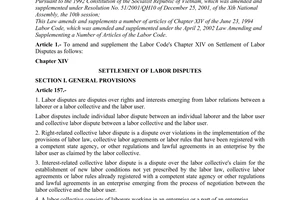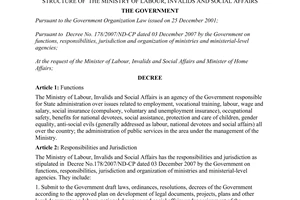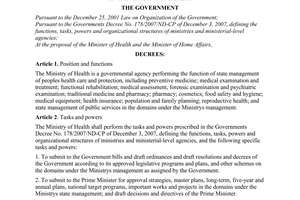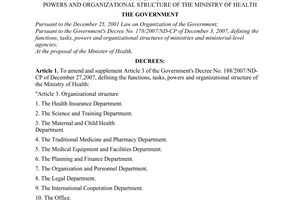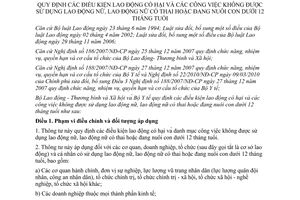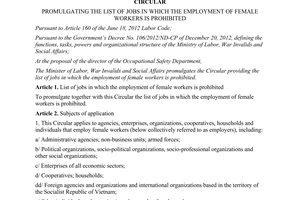Joint circular No.40/2011/TTLT-BLDTBXH-BYT defining the adverse working conditio đã được thay thế bởi Circular No. 26/2013/TT-BLDTBXH jobs in which the employment of female workers is prohibited và được áp dụng kể từ ngày 15/12/2013.
Nội dung toàn văn Joint circular No.40/2011/TTLT-BLDTBXH-BYT defining the adverse working conditio
|
THE
MINISTRY OF LABOUR, WAR INVALIDS AND SOCIAL AFFAIRS - MINISTRY OF HEALTH |
SOCIALIST
REPUBLIC OF VIETNAM |
|
No.: 40/2011/TTLT-BLDTBXH-BYT |
Hanoi, December 28, 2011 |
JOINT CIRCULAR
DEFINING THE ADVERSE WORKING CONDITIONS AND JOB CATEGORIES THAT ARE NOT USED FEMALE EMPLOYEES, FEMALE EMPLOYEES WHO ARE PREGNANT OR NURSING CHILDREN UNDER 12 MONTHS OLD
Pursuant to the Labor Code dated June 23, 1994; the Law amending, supplementing a number of Articles of the Labor Code dated April 02, 2002; the Law amending, supplementing a number of Articles of the Labor Code dated November 29, 2006;
Pursuant to the Decree No.186/2007/ND-CP dated December 25, 2007 defining the functions, tasks, powers and organizational structure of the Ministry of Labor, Invalids and Social Affairs;
Pursuant to the Decree No.188/2007/ND-CP dated December 27, 2007 defining the functions, tasks, powers and organizational structure of the Ministry of Health and Decree No.22/2010/ND-CP dated 09/03/2010 of the Government amending, supplementing Article 3 of Decree No.188/2007/ND-CP dated December 27, 2007 defining the functions, tasks, powers and organizational structure of the Ministry of Health;
The Ministry of Labor, Invalids and Social Affairs and the Ministry of Health define the adverse working conditions and job categories that are not used female employees, female employees who are pregnant or nursing children under 12 months old as follows:
Article 1. Scope of governing and application subjects
1. This Circular prescribes the adverse working conditions and list of jobs that are not used female employees, female employees who are pregnant, or nursing children under 12 months old.
2. This Circular applies to the agencies, enterprises and organizations (hereinafter referred to as the establishment of employment) and individuals that use female employees, female employees who are pregnant or nursing children under 12 months old including:
a) The administrative agencies, public service providing units, people's armed forces (people’s army forces and people’s public security), political organizations, political- social organizations, social - professional organizations, other social organizations;
b) The enterprises of all economic sectors;
c) Cooperatives and Unions of Cooperatives;
d) The agencies, foreign organizations, international organizations having their headquarters in the territory of Socialist Republic of Vietnam;
đ) The individuals or organizations that use female employees.
Article 2. The adverse working conditions that are permitted to use female employees
1. Workplace having pressure greater than atmospheric pressure.
2. Workplace at the dangerous cliff.
3. Frequent soak in water (from 04 hours per day or more, more than 3 days per week).
4. Heavy and too hard work (the average energy expenditure of more than 5 kcal/min, average heart rate of over 120/min).
5. Exposure to radioactive sources.
Article 3. The adverse working conditions that are not used female employees who are pregnant or nursing children under 12 months old
In addition to the adverse working conditions specified in Article 2 of this Circular, not to use female employees who are pregnant or nursing children under 12 months old in the following conditions:
1. Exposure to electromagnetic fields exceeding the permitted limit;
2. Direct exposure to some chemicals that its accumulation in the body easily cause mutagenic or adversely affect cellular metabolism, likely to cause miscarriage, premature birth, infection of the placenta, birth defects , adversely affect the lac feminnum, respiratory infections;
3. Soak in dirt water, prone to infection;
4. Air temperature in workshops from 400C or more in summer and from 320C or more in winter or influenced by the high heat radiation;
5. In the labor environment with a vibration higher the permitted standards, the use of machinery, equipment with vibration of whole body and local vibration is higher than the permitted standard;
6. Working posture is restraint or lack of oxygen.
Article 4. List of jobs that is not used female employees, female employees who are pregnant or nursing children under 12 months old
List of jobs that is not used female employees, female employees who are pregnant or nursing children under 12 months old specified in the Appendix attached to this Circular.
Article 5. Organization of implementation
1. Establishments of employment and individuals using employees shall:
a) Review the works that female employees are doing based on the adverse working conditions, jobs that are not used female employees as provided for in this Circular. On that basis, plans to retrain or change occupations, jobs in accordance with the health of female employees;
b) Not to arrange female employees to work in adverse working conditions and the works that are not used female employees no later than 12 months from the effective date of this Circular, but not be abused to dismiss or terminate the employment for female employees. Particularly women who are pregnant or nursing children under 12 months old, it must be made immediately after the effective date of this Circular; reports the implementation results to the local Department of Labour - Invalids and Social Affairs and the local Health Department.
c) Organize the preliminary review, summing up of the implementation of this Circular, every 6 months and annually together with the preliminary review, summing up of the implementation of safety - occupational hygiene at the establishments.
2. Department of Labour - Invalids and Social Affairs shall:
a) Coordinate with the Department of Health, Local Labor Union frequently urge to inspect and supervise the implementation of this Circular in the establishments employing female employees;
b) Enhance the inspection, detection and timely handling of the violations of provisions of law on the use of female laborers, women laborers who are pregnant or nursing children under 12 months old.
c) Synthesize, report to Ministry of Labour - Invalids and Social Affairs annually on the implementation of this Circular together with the implementation of safety - occupational hygiene at the establishments located in the area.
Article 6. Effect
1. This Circular takes effect from February 20, 2012.
2. Annul the Joint Circular No.03/TT-LB dated January 28, 1994 of the Ministry of Labour, Invalids and Social Affairs – Ministry of Health regulating the adverse working conditions and the jobs that are not used female laborers from the effective date of this Circular.
During the implementation, if any difficulties or problems arise, the concerned units, individuals should reflect to the Ministry of Labour - Invalids and Social Affairs, Ministry of Health for consideration and settlement. /.
|
FOR
MINISTER OF HEALTH |
FOR
MINISTER OF LABOR, INVALIDS AND SOCIAL AFFAIRS |
APPENDIX
LIST OF JOBS BEING NOT USED FEMALE LABORERS
(Together Joint Circular No.40/2011/TTLT-BLDTBXH-BYT dated December 28, 2011
of the Ministry Of Labour, War Invalids and Social Affairs -
Ministry Of Health)
I. APPLIED TO ALL FEMALE EMPLOYEES
1. Direct smelling and pouring molten metal in the furnaces:
1.1 Arc electric furnace from 0.5 ton or more
1.2 Bilo furnace (Cast iron)
1.3 Open-hearth furnace (steel treatment)
1.4 Blast Furnace.
2. Rolling hot metal (except non-ferrous metals).
3. Direct treatment ferrous metal ores (copper, lead, tin, mercury, zinc, silver).
4. Firing coke furnace.
5. Welding in closed containers, welding in the positions with the height of more than 10m compared to the floor surface.
6. Digging shaft furnace.
7. Digging furnace and the works in the pit.
8. Drilling for exploration, blasting, shooting mines.
9. Taking stone on mountain.
10. Installation of offshore drilling rigs.
11. Drilling for exploration of oil and gas wells.
12. Working in the oil rig on sea (except for medicl – social service).
13. Repair of power lines in underground sewers or on the columns outdoor, high-voltage power lines, erection of high voltage power column.
14. Maintenance and repair of power lines in underground sewers or on the columns outdoor, high-voltage power lines, erection of high voltage power column.
15. Maintenance, erection, repair of high poles across the river, column of antenna.
16. Working in the sunken tanks.
17. Directly aligning large panels during the work or major component by manual methods.
18. Directly digging wells, construction for completion of wells by manual methods.
19. Directly digging root of trees with diameter greater than 40 cm by manual methods.
20. Use of handheld machines run by pneumatic pressure with the pressure from 4 atmotphe or more (such as drills, hammers).
21. Driving heavy construction machines with a capacity greater than 36 horsepower such as excavators, bulldozers, caterpillars (except for the hydraulic-assisted machines).
22. The jobs of painting, repair, construction, plastering, cleaning, decoration on the outside of buildings (from floor 3 or above or at a height of more than 12m compared to the working floor) without lifting machine, gantry crane or solid scaffold.
23. Cutting large trees greater than 40 cm in diameter; sawing, cutting, pruning branches at a height of more than 5 meters by manual methods.
24. Transport of large timber, perforating, loading and unloading large timber greater than 40 cm in diameter by manual methods.
25. Diving to take submerged timbers, pulling off timber in shipyard, sending wood ashore.
26. Rafting on the river with many rapids waterfall.
27. Manual sawing of large trees.
28. Exploitation of swallow nests (except for exploitation of swallow nests in the places farming swallows), mining bat fertilizers.
29. The works on the seaships (except for the services of restaurant, room, desk, reception on the star cruises).
30. The keeping ships, looking after ships in shipyard, rock slopes.
31. Operating boiler (except for the automatic operation, operation of boiler using energy as oil and electricity).
32. Driving trains (except for trains with operating mode of high automation, the train runs through the urban areas, tourist routes).
33. Floating crane driver.
34. The sellbuilding of the ships (wooden ships, iron ships), required to carry, fit, place workpieces weight 30 kg or more.
35. Survey of river ways in the areas with high rapids, deep dangerous mountain.
36. Pouring concrete under water.
37. Divers.
38. Operating dredgers.
39. Driver of the car with a tonnage of more than 2.5 tonnes (except for the cars of under 10 tonnes with power-assisted system).
40. Other works required to carry 30 kg or more.
41. Operating the gluing machines, dyeing machines of all kinds, stretchers, polish range checkers, shrink preventing machines (except for the with operation mode of automation).
42. Laminating hard and large leather piece (except for the with operation mode of automation).
43. Drivers of agricultural tractors of 50 horsepower or more.
44. Dredging underground sewers, works required to soak frequently in dirty, smelly water.
45. Autopsy, burial, funeral of dead body (except for crematory), exhumation of graves.
II. APPLIED TO FEMALE LABORERS WHO ARE PREGNANT OR NURSING CHILDREN UNDER 12 MONTHS OLD
In addition 45 jobs that are not used female laborers provided for in Part I of this List, it is also banned the use of women workers who are pregnant or nursing children under 12 months old for the following works:
46. Works in the radio frequency transmitting stations as radio stations, television stations, and radar stations, telecommunications satellite stations contaminated by electromagnetic field exceeding the permitted standards.
47. Direct contact with radioactive sources.
48. Direct contact (including production, packaging, mixing, spraying, fumigation for warehouses) with pesticides, herbicides, drugs destroying termite, rat, mosquitoes that contain organic chlorine and some chemicals may cause mutagenic and cancer as follows:
+ 1,4 butanediol, dimetansunfonat
+ 2 Naphtylamin.
+ 2,3,7,8 tetracloro dibenzen furan.
+ 3 - alfaphenyl - betaaxetyletyl.
+ 4 - amino, 10 - methyl floic acid.
+ 4 aminnobiphenyl
+ 5 Fluoro-uracil.
+ Asbestos – type of amosit, asbestos - type of crysotil, asbestos - type of crosidolit.
+ Arsenic, calcium arsenate.
+ Axety salicylic acid.
+ Asparagine.
+ Benomyl.
+ Benzene.
+ Boric acid.
+ The insoluble chromate salts.
+ Caffeine.
+ Lead, lead acetate, lead nitrate (exposure to chemical products mixed lead such as gasoline, paint, ink and production of batteries, solder).
+ Dimethyl sunfoxid.
+ Direct blue-1.
+ Dioxin
+ Dietystilboestrol
+ Diclorometyl-ether
+ Focmamid.
+ Hydrocortisone, hydrocortisone acetate.
+ Iodine (metal).
+ Potassium bromide, potassium iodide.
+ Vinazol air tool
+ Mercapto - purines.
+ N, N-di (Cloroetyl) 2. Naphtylamin
+ Sodium arsenate, sodium arsenite, sodium iodide, sodium salicylate.
+ Coal tar, the coal tar evaporation.
+ Nitrogen pentoxyt.
+ Mercury, methyl mercury compounds, methylmercury chloride.
+ Propyl - Thio - uracil.
+ Tetrametyl thiuram disulphide.
+ Trameinnolon axtonid.
+ Thorium dioxide.
+ Theosunfan.
+ Triton WR - 1339.
+ Trypan blue.
+ Ribavirin.
+ Valproic acid.
+ Vincristin sulfate.
+ Vinyl chloride, vinyl clorid.
+ Xyclophotphamit.
49. Direct contact with chemicals harmful to the fetus and lac feminum:
+ 1.1 - dicloro - 2,2-di (4-clorophenyl) ethane.
+ 1.3 Dimethyl - 2.6 dihydroxypurin.
+ 2. sunfamilamidotazol.
+ 4.4 - DDE.
+ Andrin.
+ Antimony.
+ Betaquinin
+ Compounds containing lithium.
+ Canxiferol
+ Cloralhydrat
+ Decaclorobiphenyl.
+ Penicillin G Potassium
+ Quinidine gluconate
+ Strontium (Sr) peroxide
+ Sunfadiazin, sunfatpiridin, sunfatmetazin sodium, sunfanilamid, sunfamerazin, acetyl sunfisoxazol.
+ Cesium and salts containing cesium (Ce).
+ Xyclosporin
50. The jobs exposed to organic solvents such as soak of sleepers, spreading of emulsion of photographic paper, printing on thin film, print labels on thin glossy paper, phenol resin lamination, operation of phenol glue polycondensation pot.
51. The works in rubber production: embryonic material, weighing, sieving chemicals, working in the furnace producing latex.
52. Repair of furnace, container, steel pipes in chemical production.
53. Working in the oven fermented tobacco, pipe tobacco, cigarettes dryer.
54. Firing gas generator cooking glass, blowing glass by mouth.
55. Impregnation of leather, salting skin, handling of hides.
56. Coating paraffin in alcohol tanks.
57. Painting, welding, scraping rust in the cellars of yeast, in the closed containers.
58. Packing milk box in closed rooms.
59. Work with fuel at retail stations, testing in caves or underground: maintenance delivery, pump operation and gasoline measurement.
60. Breaking the mold.
61. Processing feathers in the open conditions.
62. Cleaning boilers, gas pipes.
63. Crushing, blend of ore or doing the jobs in the conditions of dust containing from 10% of silicon dioxide or more.
64. Enrichment of lead mineral
65. Rolling and drawing, stamping lead products, lead plating.
66. Turning filter, pressing machine in the factories.
67. Operating explosion engine from 10KVA or more.
68. Operating wire polishing machine, wire spraying machine.
69. Driving agricultural tractors (regardless of any capacity).
70. Driving construction machines (regardless of any capacity).
71. Driving cars with tonnages under 2.5 tonnes (excluding driving power – assisted vehicles); electrodynamic, the vehicles at the establishments; driving cane at the establishments.
72. Vulcanizing, forming, handling of large rubber products, such as tanks, fuel tanks, tires...
73. Carrying weight of more than 20 kg
74. Daily exposure to anesthetic vapor; the establishments producing vaccine for pretecting disease (except for the works in the indirect divisions); participation in stamping out the epidemic places; working in the zones of therapy by X-ray, cobalt ray.
75. Scooping, drying, transporting rotten fish, or working in fish powder production line of animal feed.
76. Stiring, scooping mud in the pond raising fishes.
77. The works that directly contact with dyes in the dying factories such as storekeepers, assistant storekeepers of chemical; blending dyes.
78. Packing cement with semi-automatic machine of 4 taps.
79. Installation, repair of VSAT stations (information earth stations with small antenna) in the remote, mountainous and border areas and islands.
Besides 79 works above, if the establishments of employment also have the jobs that are adverse for female laborers as specified in this Circular shall also not be used female laborers. /.
------------------------------------------------------------------------------------------------------
This translation is made by LawSoft and
for reference purposes only. Its copyright is owned by LawSoft
and protected under Clause 2, Article 14 of the Law on Intellectual Property.Your comments are always welcomed


